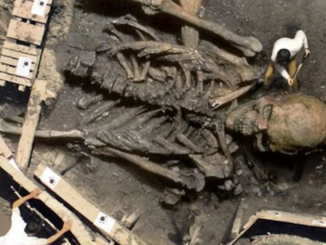
In the realm of archaeological discoveries, few are as intriguing and enigmatic as the recent unearthing of a Viking-era ring inscribed with the words ‘for Allah’. Discovered in the grave of a woman buried 1200 years ago in Birka, Sweden, this remarkable find has sparked widespread interest and raised numerous questions about the interconnectedness of cultures during the Viking Age. In this blog post, we delve into the story behind this intriguing artifact and explore its significance in the context of Viking history and cross-cultural exchange.
Unveiling the Viking ‘For Allah’ Ring
The Viking ‘For Allah’ ring was unearthed during excavations at the ancient trading center of Birka, located just 25 kilometers west of modern-day Stockholm. Dating back to the 9th century, Birka was a bustling hub of commerce and cultural exchange, attracting merchants, traders, and travelers from across Europe and beyond. It was within this cosmopolitan setting that the Viking woman, buried with the ring, lived and thrived, bearing witness to the diverse influences and interactions that characterized Viking society.
The inscription on the ring, ‘for Allah’, has sparked intense debate among archaeologists and historians, leading to various theories about its origins and significance. Some speculate that the ring may have been acquired through trade or plunder during Viking raids in distant lands, while others suggest that it may reflect the presence of Islamic traders or settlers in Viking-age Scandinavia. Regardless of its exact provenance, the ‘For Allah’ ring serves as a poignant reminder of the complex and interconnected nature of the medieval world.
The discovery of the Viking ‘For Allah’ ring sheds new light on the cultural dynamics of the Viking Age and challenges conventional notions of Norse society as insular and homogeneous. It serves as a testament to the far-reaching influence of trade, exploration, and cultural exchange during this tumultuous period in European history. As we continue to uncover the secrets of Birka and other Viking-age sites, we gain a deeper understanding of the diverse peoples and cultures that shaped the world of the Vikings.
Preserving the Legacy of Viking Archaeology
The discovery of the Viking ‘For Allah’ ring highlights the importance of archaeology in preserving and interpreting the cultural heritage of past civilizations. Through meticulous excavation, analysis, and documentation, archaeologists are able to piece together the stories of ancient peoples and unravel the mysteries of their lives. As artifacts like the ‘For Allah’ ring continue to emerge from the depths of history, they offer invaluable insights into the complexities of human experience and the rich tapestry of our shared past.
Conclusion: Reflecting on the Significance of the Viking ‘For Allah’ Ring
In conclusion, the discovery of the Viking ‘For Allah’ ring serves as a poignant reminder of the diverse and interconnected nature of Viking-age society. Found in the grave of a woman buried in Birka, Sweden, this remarkable artifact offers tantalizing clues about the cultural exchanges and interactions that characterized the Viking world. As archaeologists continue to explore the secrets of Birka and other Viking-age sites, we are afforded a glimpse into the vibrant tapestry of medieval Europe and the enduring legacy of cross-cultural exchange.


